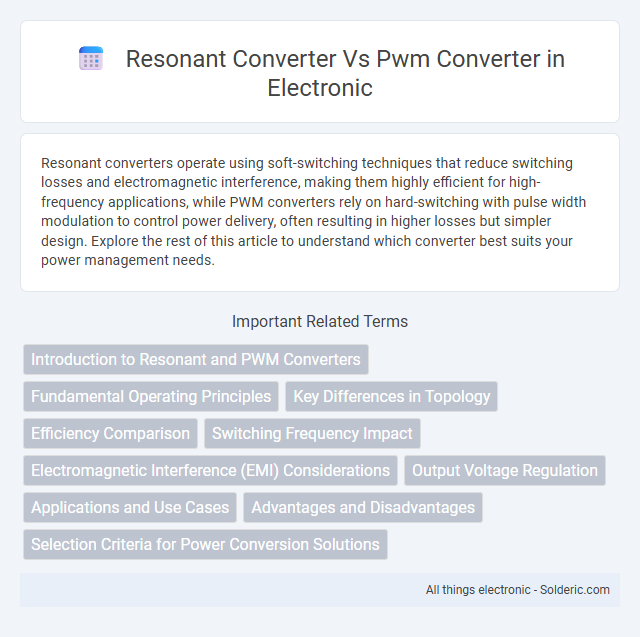Resonant converters operate using soft-switching techniques that reduce switching losses and electromagnetic interference, making them highly efficient for high-frequency applications, while PWM converters rely on hard-switching with pulse width modulation to control power delivery, often resulting in higher losses but simpler design. Explore the rest of this article to understand which converter best suits your power management needs.
Comparison Table
| Feature | Resonant Converter | PWM Converter |
|---|---|---|
| Switching Technique | Uses resonant tank circuit for soft switching | Uses Pulse Width Modulation for hard switching |
| Efficiency | Higher at high frequencies due to reduced switching losses | Moderate, switching losses higher at high frequency |
| Electromagnetic Interference (EMI) | Lower EMI because of soft switching | Higher EMI due to hard switching transitions |
| Complexity | More complex: requires resonant components and tuning | Simpler design and control |
| Application | Used in high-frequency AC/DC power supplies and induction heating | Widely used in DC/DC converters and motor drives |
| Operating Frequency | Typically high frequency (100 kHz - MHz) | Typically lower frequency (kHz range) |
| Thermal Performance | Better thermal management due to reduced switching loss | Higher heat generation from switching losses |
| Cost | Higher initial cost due to additional components | Lower cost and widely available components |
Introduction to Resonant and PWM Converters
Resonant converters utilize sinusoidal waveforms and operate at resonant frequency to minimize switching losses and electromagnetic interference, enhancing efficiency in high-frequency power applications. PWM converters modulate pulse width to regulate output voltage and current, offering precise control and fast transient response ideal for many DC-DC conversion scenarios. The choice between resonant and PWM converters depends on application requirements such as efficiency, switching frequency, and electromagnetic compatibility.
Fundamental Operating Principles
Resonant converters operate based on LC tank circuits that create sinusoidal current waveforms, minimizing switching losses by achieving zero-voltage switching (ZVS) or zero-current switching (ZCS). PWM converters control output voltage through pulse width modulation of constant-frequency switching signals, resulting in square-wave voltage and current waveforms with higher switching losses. The fundamental difference lies in resonant converters utilizing frequency modulation and soft switching for efficiency, while PWM converters rely on duty cycle modulation with hard switching.
Key Differences in Topology
The key differences in topology between resonant converters and PWM converters lie in their switching schemes and circuit designs; resonant converters use sinusoidal or quasi-sinusoidal waveforms enabled by LC tank circuits to achieve zero-voltage or zero-current switching, drastically reducing switching losses. PWM converters rely on rectangular pulse modulation with hard switching, employing transistors turned fully on or off to regulate output voltage. Resonant converter topologies include series, parallel, and series-parallel configurations, while PWM converters predominantly use buck, boost, or buck-boost topologies.
Efficiency Comparison
Resonant converters typically achieve higher efficiency than PWM converters due to their reduced switching losses and lower electromagnetic interference. The soft-switching technique in resonant converters minimizes power dissipation, especially at high frequencies, enhancing overall performance. Your choice between these converters should consider efficiency demands in applications like power supplies and renewable energy systems.
Switching Frequency Impact
Resonant converters operate at higher switching frequencies, typically ranging from hundreds of kHz to MHz, which significantly reduces switching losses and electromagnetic interference compared to PWM converters that generally switch at lower frequencies around tens to hundreds of kHz. The higher frequency operation in resonant converters enables smaller passive components, improving power density and efficiency in your power supply design. However, PWM converters offer better control precision at lower frequencies, making them suitable for applications where switching frequency impact on efficiency is less critical.
Electromagnetic Interference (EMI) Considerations
Resonant converters generate lower Electromagnetic Interference (EMI) due to their sinusoidal switching waveforms, which reduce high-frequency harmonics compared to the sharp switching transitions in PWM converters. The soft-switching techniques in resonant converters minimize voltage and current overshoot, leading to decreased EMI emissions and less stringent filtering requirements. In contrast, PWM converters produce higher EMI levels because of abrupt switching edges, necessitating complex EMI mitigation measures in sensitive applications.
Output Voltage Regulation
Resonant converters offer superior output voltage regulation by operating at variable frequencies, which minimizes switching losses and improves efficiency under varying loads. PWM converters regulate output voltage through fixed switching frequency and variable duty cycle, which can lead to higher electromagnetic interference and switching losses. Resonant converters excel in applications requiring precise voltage control and reduced noise compared to traditional PWM converters.
Applications and Use Cases
Resonant converters excel in high-efficiency applications such as wireless power transfer, induction heating, and LED lighting due to their reduced switching losses and low electromagnetic interference. PWM converters are widely used in motor drives, power supplies, and battery charging systems for their precise voltage control and fast transient response. Resonant converters suit high-frequency, low-noise environments, while PWM converters are preferred for broad voltage ranges and cost-sensitive industrial applications.
Advantages and Disadvantages
Resonant converters offer high efficiency and reduced electromagnetic interference due to soft switching techniques, making them ideal for high-frequency applications. PWM converters provide precise voltage and current control with simpler design and lower cost but may generate higher switching losses and EMI. Your choice depends on balancing efficiency and control requirements against complexity and cost constraints.
Selection Criteria for Power Conversion Solutions
Selection criteria for power conversion solutions hinge on efficiency, switching frequency, and electromagnetic interference (EMI) management. Resonant converters excel in high-efficiency applications with low switching losses and minimal EMI due to soft-switching techniques, making them ideal for wireless power transfer and high-frequency power supplies. PWM converters offer precise voltage regulation and simpler control but may suffer from higher switching losses and increased EMI, suitable for applications demanding fast transient response and wide load range.
resonant converter vs pwm converter Infographic

 solderic.com
solderic.com